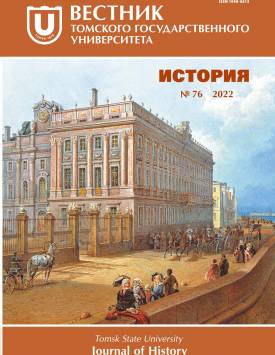Patterns and paradoxes of the October revolution of 1917
The question of the historic role and importance of the October Revolution of 1917 is still a subject of both political and ideological discussions and debates within the academic community. The questions of the historical results of the 20th century for Russia, as well as of the specifics, consequences and prospects of the modernization process in our country are inseparably linked to the question of importance of the 1917 Revolution. According to the authors of the article, today we need systemic reflection of the causes and consequences of the October Revolution of 1917 with regard to internal dynamics and contradictions in the Russian political, social and economic systems, and of the revolution as a special way of resolving these contradictions. The 1917 Revolution was a result of the large-scale systemic crisis of Russian society, economy and politics, the preconditions for which had developed by the beginning of the last century, as well as of the failed attempt of modernization “from above” which had been implemented by the authorities of the Russian Empire since the last third of the 19th century. The lack of systemic solutions to the peasant, national and workers “issues” had become a catalytic factor for the revolutionary process in Russia which fundamentally changed the structure and character of Russian society. The Russian revolution had become an attempt of a “modernization leap” to reduce the gap with the leading countries of the world and an attempt to implement the strategy of “alternative modernity” in relation to the capitalist West, which for several decades was an example for a large number of societies and countries that had chosen a non-capitalist path of development. At the same time, the development potential which was created as a result of such a “leap” was not fully realized in the second half of the 20th century despite a number of significant political, social and economic successes of our country which managed to maintain its sovereign status and the prospect of independent state and political development due to a mobilization scenario and large-scale sacrifices. Ultimately, the defeat of the USSR in the Cold War despite the enormous tension of forces meant a failed attempt to implement its declared alternative to the capitalist path of development. Based on the results of addressing the stated problem, the authors of the article conclude that the potential of such a type of modernization that was implemented by Russia in the 20th century was fully realized, and that our country needs to return to the path of consensual and qualitative evolution which will require an in-depth rethinking of experience of both recent national history and its preceding periods. Contribution of the authors: the authors contributed equally to this article. The authors declare no conflicts of interests.
Keywords
The October Revolution, systemic crisis, civil war, social transformations, global developmentAuthors
| Name | Organization | |
| Biryukov Sergey V. | East China Normal University; Siberian Institute of Management; Tomsk State University | birs.07@mail.ru |
| Andreev Andrey V. | Kuzbass State Television and Radio Broadcasting Company | andreev@gtrk.kuzbass.net |
| Barsukov Aleksandr M. | Siberian Institute of Management | amb2@inbox.ru |
| Karpov Dmitriy S. | Siberian Institute of Management | amb2@inbox.ru |
References

Patterns and paradoxes of the October revolution of 1917 | Tomsk State University Journal of History. 2022. № 76. DOI: 10.17223/19988613/76/13
